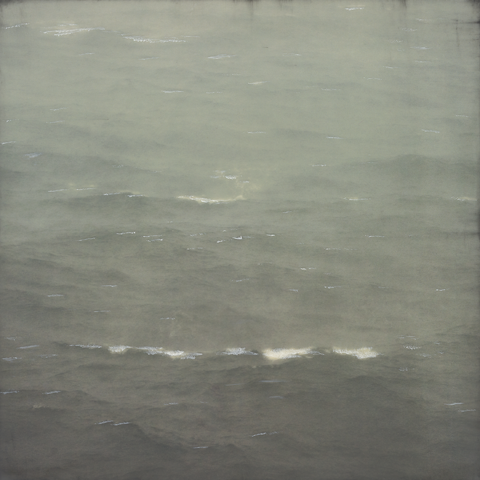
'STACKED WAVES' by Shoshannah White; 24" by 24"; 2012-13. |
Moody, romantic, luscious, fluid—words like these come to mind when viewing Shoshannah White’s atmospheric images of the sea. They are both photographs and paintings, expressing a perfect alignment of subject matter, meaning, and technique.
“Shoshannah White: Undercurrent” at the Center for Maine Contemporary Art includes 16 works from a larger series occasioned by a 2012 residency exchange program between Maine and New Brunswick, Canada. For three months, White lived on Grand Manan Island in a renovated lighthouse keeper’s residence with 360 degree views of water. This remote area of extreme tides yielded photographs of the open sea and the unrelenting forces of nature.
White’s subject is certainly not original and some of the imagery suggests visual parallels to Vija Celmins’s ultra-realist drawings and prints of choppy waters, which bear witness to her fascination with the relationship between the surfaces of paper and water; Roni Horn’s color photographs of rivers and seas, which suggest an interconnectedness between all bodies of water and ourselves; and Hiroshi Sugimoto’s black-and-white seascapes of the elemental forms of life, water, and air. Closer to home, Dozier Bell’s brooding paintings and drawings and Lisa Tyson Ennis’s toned gelatin silver prints come to mind.
The familiarity of subject has the effect of highlighting White’s thematic approach and artistic treatment. Shot on medium-format film, the image is scanned and printed in near monochrome onto watercolor paper, then mounted to panel. Layers of white or black encaustic are applied to the surface, which sometimes is mixed with metal dust. In the process, the image becomes equal parts painting and photograph—instead of smooth photographic surface, brushstrokes and drips of encaustic; instead of visual clarity, partial opacity.
In “Water Lines,” a minimal image of wave after crashing wave, the encaustic is enriched with silvery dust giving the image a reflective underground not unlike that of daguerreotypes. These large, 36-inch square works are on thick panels with black sides as if encasing the image itself, encouraging the illusion of depth, or of peeping through a pinhole back in time. In other works, smoky darkness pools around the edges of the image, evoking the liquidity of a chemical photographic process.
“Stacked Waves” is one of several pieces that feature individually brushed-on highlights and dark accents, which, when seen up close, are distractingly sitting on top of the encaustic. While this interrupts the visual reading of depth when seen at close distance, upon stepping away the retouches make descriptive sense and perfectly balance values and details.
In the most abstract and experimental work, the small “Moon Light, Dust,” silvery dust scatters and floats on black encaustic with the photographic image underneath disappearing completely. It is substituted by a painterly evocation of night at its darkest, most miraculous, and magnificent.